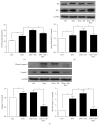N-Acetylcysteine Attenuates Diabetic Myocardial Ischemia Reperfusion Injury through Inhibiting Excessive Autophagy
- PMID: 28265179
- PMCID: PMC5317145
- DOI: 10.1155/2017/9257291
N-Acetylcysteine Attenuates Diabetic Myocardial Ischemia Reperfusion Injury through Inhibiting Excessive Autophagy
Abstract
Background. Excessive autophagy is a major mechanism of myocardial ischemia reperfusion injury (I/RI) in diabetes with enhanced oxidative stress. Antioxidant N-acetylcysteine (NAC) reduces myocardial I/RI. It is unknown if inhibition of autophagy may represent a mechanism whereby NAC confers cardioprotection in diabetes. Methods and Results. Diabetes was induced in Sprague-Dawley rats with streptozotocin and they were treated without or with NAC (1.5 g/kg/day) for four weeks before being subjected to 30-minute coronary occlusion and 2-hour reperfusion. The results showed that cardiac levels of 15-F2t-Isoprostane were increased and that autophagy was evidenced as increases in ratio of LC3 II/I and protein P62 and AMPK and mTOR expressions were significantly increased in diabetic compared to nondiabetic rats, concomitant with increased postischemic myocardial infarct size and CK-MB release but decreased Akt and eNOS activation. Diabetes was also associated with increased postischemic apoptotic cell death manifested as increases in TUNEL positive cells, cleaved-caspase-3, and ratio of Bax/Bcl-2 protein expression. NAC significantly attenuated I/RI-induced increases in oxidative stress and cardiac apoptosis, prevented postischemic autophagy formation in diabetes, and reduced postischemic myocardial infarction (all p < 0.05). Conclusions. NAC confers cardioprotection against diabetic heart I/RI primarily through inhibiting excessive autophagy which might be a major mechanism why diabetic hearts are less tolerant to I/RI.
Conflict of interest statement
No conflict of interests is declared by the authors.
Figures





References
MeSH terms
Substances
LinkOut - more resources
Full Text Sources
Other Literature Sources
Research Materials
Miscellaneous

